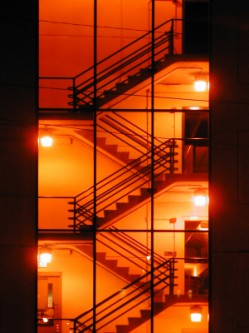 My pal Scott Underwood directed me to a fascinating study that stands at the intersection of two of my obsessions: motivation and signs.
My pal Scott Underwood directed me to a fascinating study that stands at the intersection of two of my obsessions: motivation and signs.
Say you need to go from the ground floor of a building to the fourth floor. Climbing stairs is obviously better for your health than standing in an elevator. But how can we encourage more people to choose the healthier option? One way, as Scott also showed us, is through fun. But a group of researchers tested whether it was possible to motivate behavior using signs.
Megan Grimstvedt and colleagues placed signs near the elevators of 4 university buildings in San Antonio. The sign said simply “Walking up stairs burns almost 5 times as many calories as riding an elevator” and included an arrow directing people to the nearest staircase, as well as a cartoon of the school mascot walking up a flight of stairs. Two of the buildings had very visible staircases, while two of the buildings had staircases that were relatively hidden. The buildings with hidden staircases had an additional sign on the staircase door to tell people that the stairs were accessible (e.g. no fire alarm would sound).
What happened?
- Before the signs, only 13% of people took the hidden staircases. After the signs, 25% did.
- Before the signs, 43% of people used the visible staircases. After the signs, nearly 60% used them.
- Overall, the signs increased staircase use 34%. What’s more, the increase persisted four weeks after the researchers removed the signs.
No carrots or sticks here, folks. Just information — which gave people feedback on their behavior and linked simple actions to a larger purpose. It’s Motivation 3.0 . . . with signs. I’m in nerdvana.
i wonder if the effect lasts over time?
“Can we make more people to choose the stairs by making it fun to do?”
This was the question that “The Fun Theory” people wondered and they found a very original way to achieve it (check the other two videos too):
http://www.elmero.net/2009/11/21/the-fun-theory-si-es-divertido-se-hara/
How disappointing. You said using the stairs would be more fun and I was focussed on your accompanying picture. I would guess that a stairway with a significant view like the one depicted would draw users more than an enclosed one. Stairs have become after thoughts rather than conscious designs intended to draw users. Imagine if the stairs were conveniently placed and the elevators were less promenant. Imagine if the geography of a staircase was designed to capture the human spirit. Stairwells can hardly be less uncomfortable than cramped elevators.
That’s really cool and incredibly interesting.
This does remind me of a video from a while back in Sweeden: http://www.youtube.com/watch?v=2lXh2n0aPyw
And also this video about the intersection of games and the real world is also really interesting and sort of relevant: http://g4tv.com/videos/44277/DICE-2010-Design-Outside-the-Box-Presentation/
Huh. So knowledge really is power. Go figure.
Seriously though, I wonder if there is any potential in appealing to the 10,000 steps mantra that seems to have a good toehold with some folks
I absolutely agree with this one.
Well, I strongly believe that one way or another, especially in my case as a marketer, we’re all choice architects.
I also believe that there’s always a choice, but by creatively engineering the options, we can get better decisions from people and ourselves.
Cheers!
Jurgen
+1 to Kevin, I was also reminded by the piano staircase. Perhaps not optimal in an office building, but it’s definitely a FUN staircase. For people who don’t like to check out youtube videos, it came from here:
http://www.thefuntheory.com/
I love using stairs because I know it’s an easy way to get my daily exercise but these days as a woman I’m loathe to enter windowless stairwells which are usually deserted. Part of the problem is ensuring people feel safe. We need to go back to old fashioned “open” staircases. They may take up more space, but they would create healthier and more user-friendly buildings.
All — I’ve linked to those now famous piano stairs in the text of this post. Check out the hyperlinked sentence: “One way, as Scott also showed us, is through fun.”
Haha oh. Maybe that says something about the way people read blog posts 🙂
Easy enough—I usually opt for the stairs because I’m impatient waiting on escalators (it drives me nuts when people just stand there) or for elavators LOL. Here’s another form of stair motivation: Piano stairs http://www.youtube.com/watch?v=2lXh2n0aPyw
Oh whoops I just saw Kevin posted the same link…great minds 😉
Thanks Dan. Goes to show you the power of sign design and well chosen messaging. Happy to report that open, well placed and inviting stairways are becoming mainstream in commercial architecture these days. Take the steps, it’s also a green practice.
Very interesting stuff. Imagine if we started to incorporate feedback signs into all aspects of design – there could be some considerable progress made in areas such as public health.
I concur w/Judy on the uninviting nature of stairwells. Still, I’d happily use them if there were a sign reassuring me of re-entry access on each floor and I could climb six flights with some confidence that I’d be able to get out!
Stairs are also, in general, more conducive to human interaction. It’s rare that I wouldn’t acknowledge someone passing them in the stairwell but I can’t say the same when sharing the elevator w/someone.
Totally agreed.
This is true: signs do persuade people to be more active. They are also beginning to use them within buses to persuade people to exit one stop early to walk a little bit further.
One problem: when the signs are removed, behaviour returns to normal 3 months later (http://ajp.psychiatryonline.org/cgi/content/abstract/137/12/1540).
So how do you motivate people to consistently perform this behaviour?
Now all you need is to set the experiment in North Korea and you’re all set.